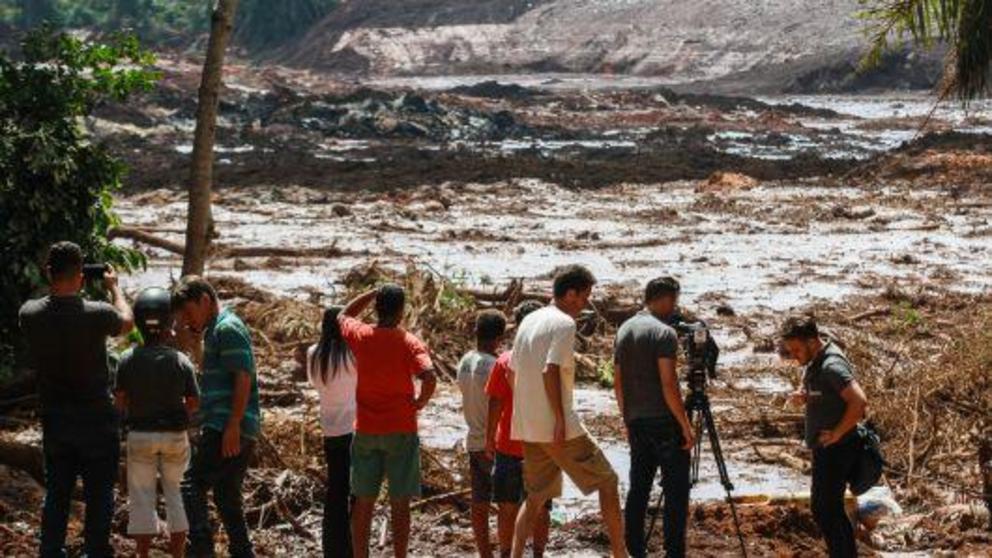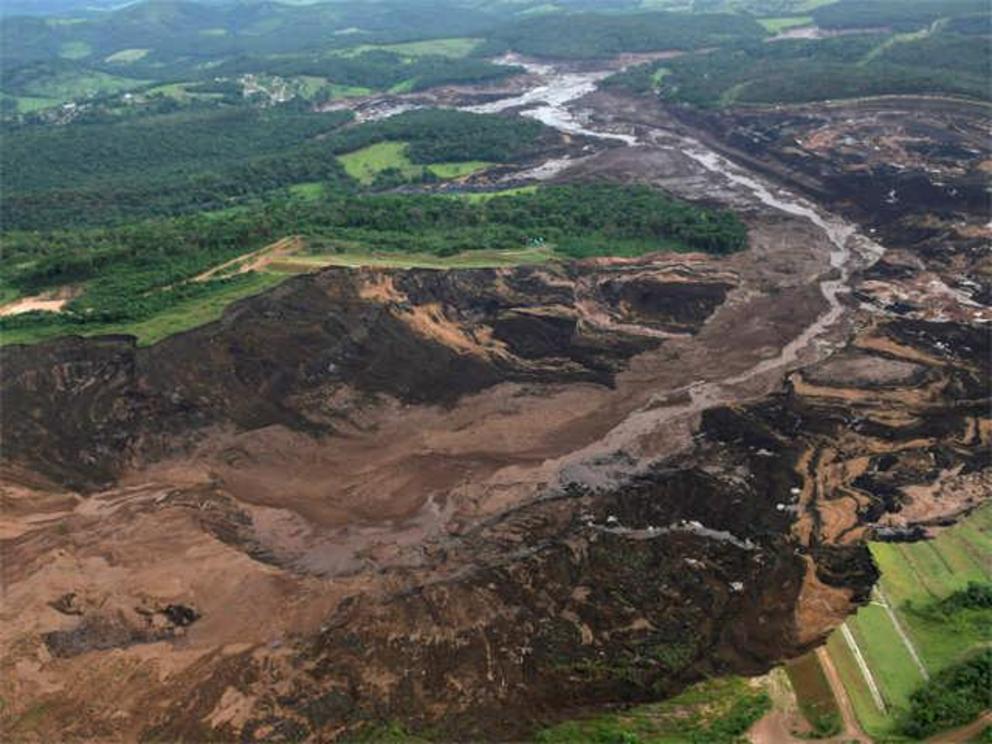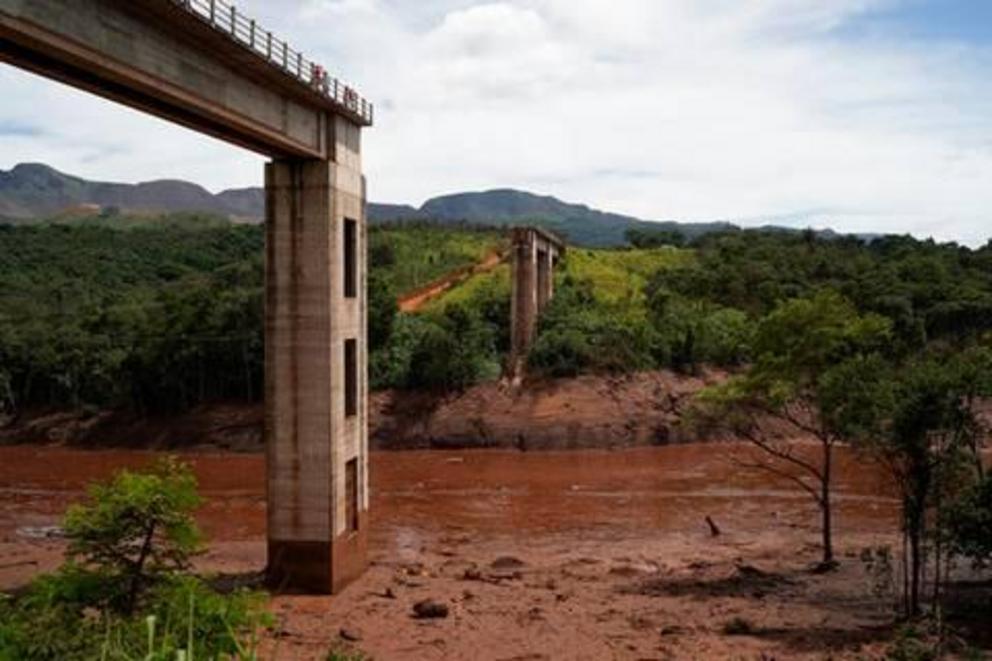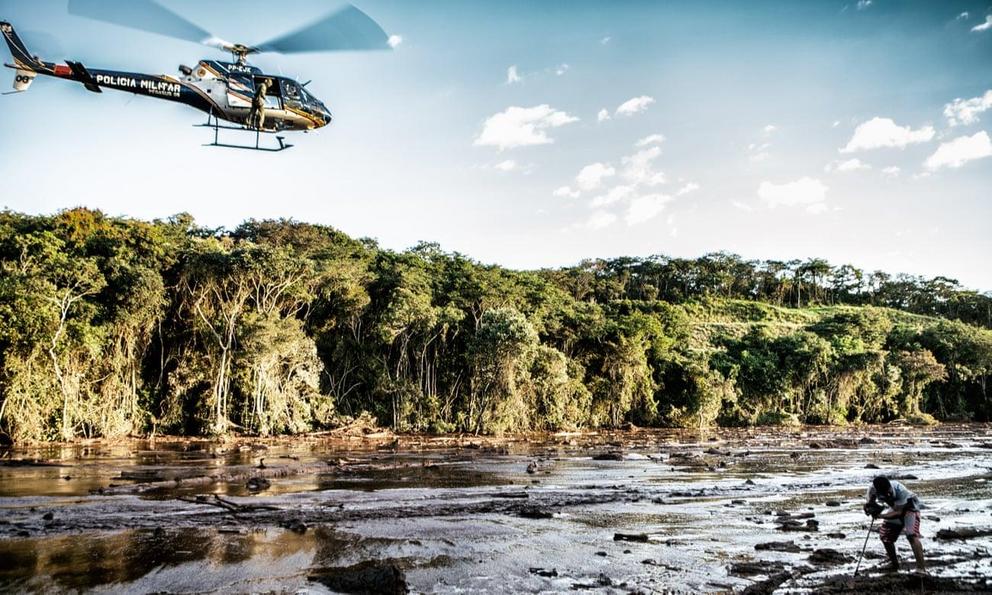Brazil dam collapse: bodies pulled from toxic mud as hope fades for survivors
The dirt road which once led to the Nova Estância guesthouse and a handful of nearby farms now ends in a slew of sticky, acrid sludge that stretches as far as the eye can see, a deep red gash across the green of the rolling Brazilian countryside.
The road, a small bridge it once crossed, the guesthouse and hundreds of people were all swallowed by mud when a tailings dam at the Córrego de Feijão mine collapsed on Friday, unleashing a torrent of liquid waste.
As the last of the daylight slipped away, a Red Cross team lugged another body in a bag across the devastated landscape and deposited it gently at the roadside for collection.
Three days after what seems likely to become Brazil’s worst ever environmental catastrophe, Red Cross rescue worker Walter Moraes said the victim was “apparently” a man. “It is already decomposing,” he said.

Hundreds more bodies remain buried. But finding the missing victims poses an almost impossible challenge for the recovery crews: the disaster sent 11.7 m cubic meters (413 m cubic ft) of mining waste thundering through the valley, swamping houses and leaving a sea of clotting mud up to 8m (26ft) deep in some places.
So far, 60 bodies have been found near Brumadinho in Minas Gerais state. But, as of Monday afternoon, 292 people were still missing – and hopes were fading fast that there will be any survivors. Nobody has been brought out of the disaster area alive since Saturday.
Frustrated with official rescue efforts, some locals have started searching for bodies themselves, said Petterson Chaves, 23, who stood watching nearby. “The people can’t stand there waiting for friends and relatives,” he said. “They’re out there hunting [for them].”
Among the missing is Chaves’s aunt Elisabeth Reis, 49, a cook at the opencast mining complex where the 86-metre-high tailings dam collapsed on Friday afternoon, releasing the devastating red wave.
Reis worked at the site’s canteen, which was full of workers having lunch when the disaster struck. Just last week, she had told relatives she wanted to leave her job at the end of the year, after paying off a car loan and finishing off her roof. “She was scared the dam would fail,” he said.
The Brumadinho disaster came just three years after the collapse of another tailings dam, near the town of Mariana, also in Minas Gerais. That disaster killed 19 people, polluted the drinking water to hundreds of thousands, and sent mud hundreds of kilometres downriver to the sea. Nobody has ever been convicted of any responsibility for the Mariana disaster.
The Mariana dam was owned by a joint venture between BHP Billiton and the Brazilian mining company Vale, which also owns the Brumadinho dam. Locals simply cannot believe that the same thing has happened again: another tailings dam, in the same state.
Jane Luzzi, 51, escaped by the skin of her teeth when the mud roared past her rural community of Parque de Cachoeira, taking the house where she made snacks to sell with it. No siren sounded to warn her: instead she got a breathless voice message via WhatsApp from her landlady.

“Jane,” her landlady shouted. “The dam has burst. Get out of there quick, in the name of Jesus!”
Luzzi grabbed her husband, Nilton de Freitas, 64, and they fled, shouting at neighbours as they went. Now, all she has left was in a plastic bag at her feet.
Under the hot afternoon sun, Luzzi’s anger boiled over. “They think the people under that dam are insects,” she said. “Where is the United Nations? Where are the people who work with human rights?”
Officials have not yet concluded why the dam failed, but the attorney general, Raquel Dodge, has promised to launch an investigation. “Someone is definitely at fault,” she said.
Before the disaster, the river which ran through Parque de Cachoeira ran with crystalline water – clear enough to see fish swimming, said Adriano Souza, 36, a local builder and painter who has been helping hunt for bodies.
His cellphone was filled with grim videos and pictures of broken bodies in the mud, along with a mud-caked child who had been rescued alive.
Souza stood watching a rescue helicopter hovering above the acrid sludge. “If we have any contact with it we have to wash ourselves and wipe down with alcohol,” said Souza.
As the sun dipped over the trees, three young men waded into the mud to point out a human leg they had found. A police helicopter descended and an officer in green overalls marked its location with a striped pole.
“We found two bodies today,” said Afonso Ferreira, 20, as he waded out, his bare legs caked in red filth. “You can’t recognise them.”

Up close, the mud irritates the eyes and throat due to the high pH levels in iron ore mining waste, said Mark Macklin, a professor of physical geography at the University of Lincoln who has studied tailings dam disasters for decades and is director of the university’s new Water and Planetary Health centre.
Residents have described fish dying in the nearby Paraopeba river while others circulated cellphone videos of fish leaping out of the water to flap on its banks.
“The fish will be choking because of the very high sediment loads in the river that simply stops the fish from breathing. They die from lack of oxygen,” Macklin said.
“There were many dead fish, fish suffocating, fish jumping out of the water. I have lived here 58 years and I have never seen a scene like this,” said Ouvido Gomes, 68, a carpenter.
Compounding the anger building in the region is the fact that some locals had already protested against the dams which they feared could collapse.
Bruna Coelho, 23, an unemployed biologist who grew up in the region, took part in some of the protests. “We were very worried, especially after Mariana. Everyone who lives near tailings dams was worried,” she said.
So far, Vale has denied any suggestion that the company might bear some responsibility for the Brumadinho disaster. In interviews, Vale’s CEO, Fábio Schvartsman, has referred to the tragedy as an “accident”.
“Vale does not see any decisive reasons for its responsibility. There was no negligence, recklessness, malpractice,” Sérgio Bermudes, a lawyer for Vale, told the Folha de São Paulo newspaper.
Vale soon moved to distance themselves from the comments. “Vale clarifies that it did not authorise third parties, including contracted lawyers, to talk in its name,” the company said in a statement on Monday, insisting that it will continue contributing to investigations and supporting affected families.
Marina Silva, the former environmental minister and presidential candidate, said congress should bear part of the blame for not toughening regulations and enforcement.
“All the warnings have been given. We are repeating history with this tragedy,” she told the Associated Press. “Brazil can’t become a specialist in rescuing victims and consoling widows. Measures need to be taken to avoid prevent this from happening again.”
For the rest of this article please go to source link below.

